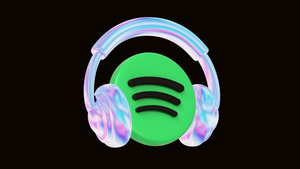Finally! Spotify is adding lossless audio to its premium service, higher quality audio being “one of the most anticipated features” according to an official statement. Which is true, it has been highly anticipated. But only because Spotify has been promising higher quality audio for at least 300 years.
So long has it been promising this feature, in fact, even Spotify subtly acknowledges how long the wait has been in that official statement, by italicising the word ‘finally’ when declaring that “finally, lossless audio has started rolling out to premium listeners in select markets”.
Of course, Spotify has been promising this feature for so long, most people have stopped caring, meaning the announcement - now that it has finally come - is a little bit of a damp squib.
“We’re so excited lossless sound is rolling out to premium subscribers”, says Spotify’s VP Subscriptions Gustav Gyllenhammar - though to be fair he’s paid to be excited about this, and even then doesn’t really manage to sound like this is any more exciting than, say, a supermarket grocery delivery.
“We’ve taken time to build this feature in a way that prioritises quality, ease of use and clarity at every step, so you always know what’s happening under the hood”. Which is, I guess… nice?
It’s always good to know what is going on under the hood when you’re listening to music, rather than just clicking play and having music happen.
With lossless, Gyllenhammar adds, “our premium users will now have an even better listening experience”. Just like users on Apple Music, Amazon Music, Tidal, Qobuz, or just about any other mainstream music streaming service. Hurrah! Backslapping all round for the Spotify executive team.
There was a time, of course, when higher quality audio on music streaming platforms did seem exciting. That time was 2013, when the other Nordic-founded streaming service, WiMP, first started offering lossless audio to its users.
WiMP then morphed into Tidal, which made higher quality audio central to its offer. Twelve years is a long time in music streaming, but clearly Spotify likes to make sure that everything under the hood is just right.
Back in 2013 higher quality was only available to users who paid more money, with many in the music industry hoping that charging double for lossless audio was a way to increase the average revenue per user in streaming.
But it turned out that most people don’t really care that much about higher quality audio - particularly given that a lot of people listen on cheap headphones that don’t actually support the highest quality.
In fact, even Apple, with its highly controlled device ecosystem, only offers its highest quality audio on its eye-wateringly expensive Airpods Max headphones - and then, only if you connect to your device using a USB C cable.
So, overall sign-ups to higher priced higher quality audio subscription tiers were fairly modest, with the types of audio nerds who deeply cared about the highest quality audio on their streaming platform often decamping to specialist services, like Tidal and Qobuz.
Then, in 2021, Apple Music pulled the rug from under everyone’s feet when it decided that higher quality audio - including spatial audio - should come as standard, because, you know, if everyone has access to it, Apple can sell more of the headphones needed to really benefit from the experience. Even if you do need to plug them in with a clunky old cable to get the full experience.
Amazon Music quickly followed Apple’s lead in making lossless part of its standard subscription tier. And then, in 2024, even Tidal - the pioneers of high quality audio - announced it was ditching its highly priced HiFi Plus tier and would also offer its highest quality audio as part of its standard 10.99 a month subscription.
Spotify formally promised that higher quality audio was coming to its platform soon back in 2021. But it kept getting delayed. There were then reports that lossless audio would be part of a higher priced super premium product - another thing Spotify has long been promising - despite most of its competitors now offering higher quality audio as standard.
However, it turns out lossless will not cost extra, becoming available this month to all premium subscribers in Australia, Austria, Czechia, Denmark, Germany, Japan, New Zealand, the Netherlands, Portugal, Sweden, the US and the UK, and to a total of 50 markets by the end of October.
“With lossless, you can now stream tracks in up to 24-bit/44.1 kHz FLAC”, says the official blurb, “unlocking greater detail across nearly every song available on Spotify. So you can enjoy new releases and your favourite tracks, in the highest quality, while being immersed in the music”. Assuming that your £7 Temu bluetooth headphones can cope with it.
Whether that’s as good as or better than Apple’s 24-bit/192kHz ‘Hi-Res Lossless’ audio is something that beard-stroking audio nerds will have to fight out amongst themselves some other time.

